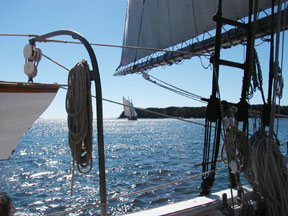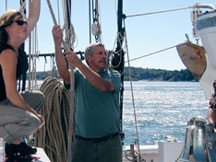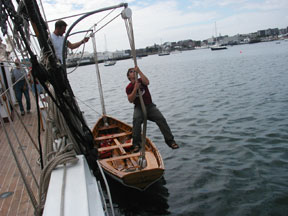Excerpt from our first schooner cruise, in 2003. We spent last week aboard the schooner Heritage, out of Rockland, Maine, for our sixth trip.
Monday
When I awoke again, it was with a start, at the sound of heavy metal chains being tossed on the deck immediately above my head, and water sloshing from a bucket, and young male voices. No drowsy lingering in bed this morning! Clearly, work was being done above us, and it was time to get up. Art’s bed was empty.
I dressed quickly and climbed the stairs. We’d been told the night before that the best time to shower was after 9 in the morning and before 9 at night. The water for the shower was heated by the wood stove in the galley, and hot water would be more plentiful between those hours, when there was no cooking going on. I felt a little disheveled without a shower and clean hair, but I figured everyone else would be in the same spot, so it didn’t matter much. I had it in my mind to take my shower early in the afternoon each day of the cruise.
On deck, a small cluster of men stood around a coffee pot. I heard snippets of conversation about work, past sails, sports and politics. Someone handed me a mug of coffee – strong and not too hot, it still contained the caffeine I need in the morning.
I joined a small group of women nearer the galley. I remembered them from the night before -- Marjorie, an energetic, humorous, outspoken woman from New Orleans; Sally, a tiny Californian; Karen, who reminded me of my friend Barbara. And another woman I hadn’t met – as it turned out, Joanne, half of the couple in the motorhome who’d spontaneously decided to join this cruise. The women welcomed me with smiles. We identified the morning people and the night people. I was glad to see I was not the only person who wasn’t fully awake and perky.
Within minutes, the meal bell clanged, and we descended to the galley. Steaming serving bowls of wonderfully seasoned scrambled eggs, plates of perfectly prepared bacon, stacks of toast with jars of homemade jam and marmalade, earthenware pitchers of fruit juice, bowls of fruit, pots of hot coffee. Really, we couldn’t have asked for a more filling breakfast. We passed the food until we were all stuffed, and then we passed it again.
Captain Doug spoke to the group. “We’ll be setting sail at about 10:30,” he said, “So if you want to leave the schooner, be sure to be back by then.”
When almost every scrap of food had been consumed, Captain Linda instructed us on the remaining kitchen tasks. “Stack and pass,” she said, meant to move all plates, silverware and bowls to the two ends of the horseshoe table, scraping into one of the serving bowls as we went. As we complied, crew members Nellie and Trevor moved swiftly to gather up the remaining jams and condiments into storage containers for later use. An oversized sink was filled with soapy water, and an assembly line was set up for washing, drying and putting away the dishes. Most of the men had returned to the deck, and a few of the women were already playing cards in the corner of the galley, but the clean-up crew talked and laughed as they made fairly short work of the breakfast dishes.
It was a nearly clear day, with just a few clouds, temperature in the low 60s. As soon as all the passengers were aboard, the captain gave notice to hoist the gangplank, to cast off the lines, and the crew pulled the ship back into deeper water before tossing the last line back to the dock. The yawl boat had been lowered, and Captain Linda had brought it around to pull the schooner out into the channel, and then came about and turned the boat out seaward. I was watching Captain Linda. It was surprising to me that a ten-foot yawl boat could maneuver the 150-foot schooner using only one rope (Art says “they call them lines”) tied off between the two craft. Then the yawl boat was secured and the hoisting of the sails began.
I had decided that I would participate in the sailing. In the past, I’ve sat on the deck and watched as our friends Bob and Sheila, and Art, worked the sails. I suspected that my experience on this trip would be enhanced if I did more than watch others work. Still, I felt awkward. I’m inexperienced in sailing, and I knew that a number of the other passengers had done this before. As a matter of fact, the single man, Merv (actually, he is married, but his wife is a golfer rather than a sailor, so she was at home in California), had mentioned that he belonged to a sailing club and had sailed on many other occasions. I was an amateur, but I didn’t want to look like one. Hopefully I could help in a way that wouldn’t call attention to my seagoing clumsiness.
Art, on the other hand, had been interested in this cruise specifically because it was a working schooner. He wanted to see how it was sailing a larger ship rather than just the small sailboat that one person could operate.
Preparations for getting underway was directed by Captain Doug. The website for the schooner describes it this way:
Attention to tradition makes the new schooner Heritage an authentic Maine coasting schooner. When it's time to hoist the anchor and raise the sails, the authentic 1917 deck engine can be called into service. The distinctive sound sings out as the gaff inches its way up the mast, sails unfurling ready to catch the wind again.
 Noah, the first mate, started the deck engine. The crew kept the lines free and directed the participating passengers. Here’s an example of a direction. Nellie said, “I need two flowers (pronounced “flow-er” with a long “o”). I said, “What is a flower?” She said, “Let this line run through your hands. Don’t try to stop the line. Just keep it flowing smoothly.” I could do that. I was a flower on that occasion.
Noah, the first mate, started the deck engine. The crew kept the lines free and directed the participating passengers. Here’s an example of a direction. Nellie said, “I need two flowers (pronounced “flow-er” with a long “o”). I said, “What is a flower?” She said, “Let this line run through your hands. Don’t try to stop the line. Just keep it flowing smoothly.” I could do that. I was a flower on that occasion.Meanwhile, Art had taken up a position as a puller; those people hoisted not the mainsails (that was what they had the engine for), but the topsails and the foresails (pronounced “topsles” and “forsles”). The pullers were in groups of three, usually two men and one woman, and they reached up the line, grasped it, and pulled it down, reached up again, pulled down again. Kind of like raising a very heavy flag. Art says, “We were actually working the fall line of a set of four block and tackle”– a set of four pulleys in a block to reduce the amount of human effort required.

While the sails were being hoisted, we listened carefully to the called instructions of crew and both captains. The idea is, while the pullers are raising the sails, the flowers are releasing the line that will eventually pull the sails down, and they will flow on the fall line of the blocks. I admit that these words are Art’s. He has explained this scenario to me at least three times since we returned from our trip, and I still don’t get it. That’s why, when I started writing about the sailing of the schooner, I asked Art to give me the words. He wishes I would learn the concept so that he can work on his crossword puzzle undisturbed.
The sails in place, the lines had to be made up and secured to the davits. Translated, that means they were coiled in a specific configuration, always clockwise because of the lay of the line. Then they are tied up to secure the sails and placed on the mast, so that they’re not in the way and so that when they’re needed again when the sails are unfurled the lines will fall easily. I learned that the discipline of sailing is intensely practical. That’s probably why Art understands it better than I. His work as the foreman of a line crew for the electric company requires the same disciplined, practical approach.
We were now headed out of Rockland harbor. As we were departing, we passed a lobster boat returning to port. It looked like a garbage scow because of the innumerable seagulls following it. Lobstering is a primary industry in this part of the country. We were looking forward to one of the featured events of this cruise – a lobster feed one evening on an island beach.
We made up the lines, and numerous passengers were gathered around Captain Doug and his compass and charts to see exactly where we were going and what the layout of the area was. Other passengers – me included – found positions by the rail or on seating areas on the open deck. On this cruise, we could do whatever suited us during the day’s sail.
Doug listened to several radio channels – NOAA (National Oceanographic Atmospheric Something) and other boats to ascertain the weather and the wind and to chart our course for the day.
It was in the mid 60s, with a blue sky and cirrus clouds. Just about a perfect day, in my mind, for a sail. Once we were on the water, I went to our cabin and found my book – not the one I read aloud to Art at night, but a Nora Roberts romance – perfect for passing time and not requiring much thought. I put on my shorts, slathered my legs with sunscreen, and found a deck cushion and an empty spot for reading.

Art was watching the water and helping when the captain needed hands for coming about. Art didn’t see much on the water of interest, though he did hear someone on the radio say they had seen a whale.
I looked up from time to time from my book to chat with a fellow passenger – I had good long conversations with Sally and Joanne that day – and to notice the ever-changing color and texture of the water. On this day, there were times when it looked like silken glass.
Lunch was served on deck. It consisted of steaming cauldrons of homemade soup and multiple loaves of warm homemade bread with butter, jam, cashew butter and peanut butter. We served ourselves buffet style. It seemed to me that we had eaten breakfast only a short time before. I wondered how I could eat again. I had exercised not at all after the plentiful breakfast. This lunch was one of those where you are full and yet you eat more, cursing yourself for your gluttony.
During the afternoon, Art spent his time listening to Captain Doug talk. The man has been sailing schooners for over 30 years, and he has an endless supply of stories to tell to just about anyone who will listen. His stories are about building the schooner and some of the difficulties he ran into; different trips that they had and things that happened on each trip; and, always, stories from his youth. As Doug talked at the wheel, watching the wind and the sails, Captain Linda was all over the schooner – directing the kitchen activities between meals, teaching passengers how to work as a team in hauling up the yawl boat, supervising the youthful crew, and making sure that every passenger was comfortable.

When Doug and Linda’s two daughters, Clara and Rachel, were growing up, they spent their summers aboard the schooner, meeting passengers from all over the country and the world. Those girls are now young women. One graduated recently from college and now works at Google, an Internet company in California. The other recently entered a prestigious university on the east coast. Most likely they had a very well rounded pre-college education.
Midway between lunch and dinner, crew member Gretchen ascended from the galley with an overloaded tray of lemon bars, hot from the oven. I couldn’t believe we were expected to eat again. Fortunately for me, sweets are not unbearably tempting, so I was able to say no to all but the first bar. Art succumbed to his gigantic sweet tooth and corresponding appetite and love for lemon bars. I have no idea how many he ate, and I have no plans to ask.
I remember when I first met Art, I could always find him, at a potluck, standing beside the food table. I remember also a mutual friend who approached me on one of these occasions and asked, “Why doesn’t Art explode?” I worry sometimes that his appetite for sweets and fats will be detrimental to his health, but I have learned through the years to keep my mouth shut most of the time. On this cruise, I figured I’d have a better time myself if I didn’t watch Art at table.
In late afternoon we pulled into a cove on Swan’s Island. Doug looked around and decided against anchoring there, so we sailed around the island to another cove, where we dropped anchor, dropped the sails, learned how to put them away, made the lines fast for the night, and set up the tarps to keep the dew off.
Here is the day’s entry in the captain’s log:
Monday, 32 miles, sunny and foggy – a nice sail “Down East” – through the Deer Isle Passage and York Narrows. Anchored in Mackenak Cove on Swan’s Island. Saw osprey and seal.Dinner was ready long before I was hungry. The meal was comfort food – platters of baked chicken, fresh steamed vegetables, and boiled new potatoes.
That night after dessert (I can’t even remember what it was, but I know it was wonderful), Captain Doug told his first Archie story. I’d heard about these yarns during the day from repeating passengers, but had no idea what they were. Archie, as Doug tells it, was a childhood friend who had endless escapades and encounters with the world, real and make believe. Simple events could be turned into classic misadventures. Doug could string that story along for fifteen minutes, until the population of the entire galley was hanging on his every syllable. When the climactic moment of the story arrived, passengers let out a communal belly laugh, often punctuated by groans of pain from laughter or sometimes as a comment on the quality of the pun at the end. I wish I could do justice to these stories, but, really, you had to be there. Suffice it to say, Archie was the guest star every single evening after dinner.
I lay awake for a while after I turned off the reading lamp. I could hear Art snoring lightly above me. He almost always falls asleep within a minute or two of lights out – probably the result of years of sleep deprivation he experienced as a lineman working emergency jobs at night. In such a situation, the crews learn to fall asleep almost instantly while the driver of the rig is taking everyone to the next job. I am sometimes envious of the ease with which Art falls asleep. Lying in the darkness in my bunk, I listened to the unfamiliar night noises on the schooner – the creaks of the boards, the flush of the head on the deck above me, a foghorn, a set of snores from one the cabins close by. And then, a groan.
I had a moment’s concern at this noise, because I recognized the voice. One of the women, Charlotte, a 47-year-old widow traveling with her companion, Ray, an accountant at least 20 years her senior, represented herself as something of an invalid. Indeed, she wore a breathing tube in her throat. Aside from that, though, she appeared to be in excellent health – she had a boisterous laugh and an energetic manner. She confided easily in new acquaintances – she had told me earlier in the day that she had recently lost over a hundred pounds since having her stomach stapled – which would have put her at around 400 pounds before her surgery. And her numerous flirtatious, suggestive comments to her companion were, to my way of thinking, a bit on the risqué side in the company of near strangers – though he didn’t appear to mind in the least.
At any rate, when I heard the groan I wondered whether she was having trouble breathing. As I listened further, though, I realized I was mistaken. The woman got noisier and the groans changed to moans and then to muffled shrieks. I was somewhat embarrassed to be listening in on an intimate encounter between this professed invalid and her companion. They weren’t more than eight feet away; through walls as thin as the schooner’s, it seemed like much less distance. I wondered if they knew they could be heard.



4 comments:
Oh, my!
Travel is a great way to make memories.
Wow, thanks for taking us along on your ride!
You have totally sold me. I always wondered how much work was required on these trips but it appears it is up to you.
Totally cracked up at the last part of the story. Probably better to read about than to hear though.
Post a Comment